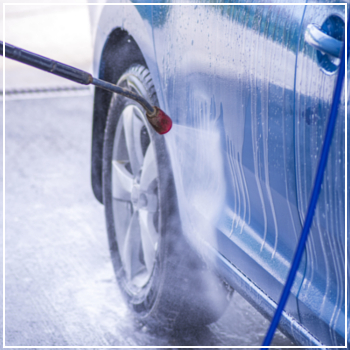How Pressure Washing Affects Your Car’s Paint Job
 Many DIY car lovers swear by pressure washing to give their vehicles a fresh, brand-new look. It's seen as a fast alternative to traditional hand-washing and waxing.
Many DIY car lovers swear by pressure washing to give their vehicles a fresh, brand-new look. It's seen as a fast alternative to traditional hand-washing and waxing.
With the current situation, doing it yourself at home might seem like the best choice. But if you're not careful, pressure washing can actually do more harm than good. It can strip away your car’s paint, expose the metal underneath, and even lead to rust over time.
If you’re planning to try this method, here are some key things to keep in mind before getting started.
How to Pressure Wash Your Car the Right Way
Pressure washing isn’t just about turning on a hose and blasting water. These systems come in different types—electric or gas-powered—and have varying levels of pressure (PSI) and flow rate (GPM). The right combination is essential to avoid damage.
Here are some important tips to follow:
- PSI and GPM: PSI measures the pressure of the water, while GPM refers to how much water flows per minute. For a standard car, aim for 1,200 to 1,900 PSI and 1.4 to 1.6 GPM. Too much pressure can damage the paint or even crack the windows.
- Electric vs. Gas: Electric models are safer for cars because they offer less power. Gas units are more powerful but risk damaging your vehicle if not used properly.
- Nozzle Angle: Nozzles range from 0 to 65 degrees. A 15-degree nozzle is ideal for rinsing or applying soap, while narrower angles are too strong for the car’s surface.
- Where You Park: Make sure your car is away from plants, people, pets, and other objects to prevent damage or accidents.
Before you start, close all the windows, doors, and trunk. Stand at least four to five feet away when rinsing off dirt and debris. Use a car-safe detergent, and always make sure the brush you use is clean to avoid scratches.
Wear closed-toe shoes to protect your feet from high-pressure water, which can be dangerous if it hits your skin directly.
What Can Go Wrong?
According to Consumer Reports, pressure washing your car isn’t recommended due to the risks involved. High pressure can scratch or remove paint, leading to rust. Even small particles like gravel can become abrasive when combined with the force of the water.
Other common mistakes include:
- Not cleaning the car and undercarriage thoroughly first, which can cause scratches from dirt being forced into the paint.
- Using the wrong detergent, such as dish soap or laundry detergent, which aren't safe for vehicles.
- Washing from bottom to top or holding the stream in one place too long, which can damage the finish.
- Trying to wash parts like the engine or plastic components, which can be damaged by the high pressure.
- Not using the correct settings or standing too close, increasing the risk of injury or damage.
If you're unsure or inexperienced, it's better to leave the job to professionals. At DaSilva’s Auto Body, we offer expert exterior detailing and rust removal services. Contact our Naugatuck location today to schedule an appointment and keep your car looking its best without the risk.
General Mechanical Parts,Steering Wheel Mould,Building Construction Material,Auto Steering Wheel Cover For Car
CHANGGE FUKANG MACHINERY ACCESSORIES CO. ,LTD , https://www.fukangcasting.com
